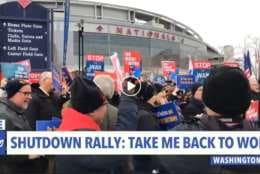Government Shutdown
-
National Commission on Military, National and Public Services rolls out ideas amid the longest partial government shutdown ever.
January 22, 2019 -
In today's Federal Newscast, a new study in the Journal of American Medicine Association finds veterans waited fewer days in 2017 than 2014.
January 22, 2019 -
Will the government shutdown of 2018-19 trigger the massive brain drain some experts have been predicting since the late 1990s? Or, has it already happened, thanks to four shutdowns in a 12-month period?
January 22, 2019 -
Absence rate among unpaid government airport screeners hits 10 percent
January 21, 2019 -
The longest partial government shutdown in history is now a month and counting and several banking institutions announced a variety of loans and other special assistance to members affected.
January 21, 2019 -
Several agency CIOs and IT executives told Federal News Network that their systems and data are well protected, but the loss of the contractor workforce could be devastating.
January 21, 2019 -
The longest government shutdown in history is of course affecting agency operations, but what about the mindsets of their employees?
January 21, 2019 -
In today's Federal Newscast, Representative TJ Cox's (D-CA) first introduced legislation in Congress is meant to ease the financial hardship furloughed federal employees are currently enduring.
January 21, 2019 -
You probably know that today is a federal holiday although during a time of multiple shutdowns it is sometimes hard to know what’s happening and to whom, and for how long.
January 21, 2019 -
The State Department has enough non-appropriated funding to bring its domestic and overseas employees back with pay for more than two weeks, and has looked at ways to remain open beyond that period as the partial government shutdown ends its fourth week.
January 18, 2019 -
Federal workers and their unions are not finished voicing their thoughts on the partial government shutdown, which hit 28 days ago on Friday. Around the country employees rallied in protest this week, demanding an end to the impasse between Congress and the White House and the return of their paychecks.
January 18, 2019 -
Agencies need to send second furlough notices if the government shutdown goes beyond 30 days, the Office of Personnel Management said.
January 18, 2019 -
The Washington, D.C. area has been feeling the pinch of the partial government shutdown. Fewer federal employees are around to buy stuff or even ride the Metro.
January 18, 2019 -
With a spike in the number of furloughed federal employees seeking unemployment benefits, some workers have sought to make up for lost income by taking advantage of the "gig economy."
January 18, 2019 -
In today's Federal Newscast, two senators asked the Transportation Security Administration for its plan if staffing shortages and call outs continue.
January 18, 2019














